ISSN ONLINE(2319-8753)PRINT(2347-6710)
ISSN ONLINE(2319-8753)PRINT(2347-6710)
Dr. S.K .Chinta.1 , Prof. S.M .Landage.1 and Krati yadav2
|
| Related article at Pubmed, Scholar Google |
Visit for more related articles at International Journal of Innovative Research in Science, Engineering and Technology
In this work chicken feathers were utilized to produce nonwoven by spray bonding technique using three chemicals such as polyvinyl acetate (PVAc), Dimethylol Dihydroxyl Ethylene Urea (DMDHEU) and polyurethane(PU) at different concentration varying from 10-50 parts. It is observed that, polyvinyl acetate gives better performance as compared to PU, DMDHEU in all respects. The values of GSM, Bursting strength, Thickness, water resistance is good in all respects as compared to other resins. Also as the concentration of resin an increases there is decrease in air permeability in as of polyvinyl acetate as compared to other resins.
Keywords |
| Chicken Feathers, Chemical Bonding, Nonwoven, Thermal Bonding |
INTRODUCTION |
| An estimated 15 million tons of chicken feathers are produced globally each year as a by-product of meat manufacture. The raw material is tough and chemically resistant. Currently the feathers are disposed of in landfill, burned or processed to make a low-grade animal feedstock. These methods are environmentally unsound and are restricted. To overcome this problem, the chicken feathers are used in manufacturing of nonwoven. Nonwoven fabrics are broadly defined as sheet or web structures bonded together by entangling fibre or filaments (and by perforating films) mechanically, thermally or chemically. They are flat, porous sheets that are made directly from separate fibres or from molten plastic or plastic film. They are not made by weaving or knitting and do not require converting the fibres to yarn. In the present work, chemical bonding process is used for manufacturing of nonwoven. |
MATERIALS AND METHODS |
A.Materials |
| In the present work chicken feathers were collected from different poultry farms in the local area. PU, DMDHEU, Polyvinyl acetate and other chemical were used of LR grade. |
B.Methods |
| Collected chicken feathers were cleaned to remove dirt ,dust by using soap solution After cleaning feathers were dried and cut. The quill has been separated from the feathers. |
C.Manufacturing of nonwoven |
| Nonwoven is manufactured by using varying concentration of PU, DMDHEU and Polyvinyl acetate The concentration varies from 10-50 Parts and other ingredients kept constant. The nonwoven prepared is then dried at cured at 140ºc for 60 sec. |
TEST PROCEDURES |
| Following tests are performed for evaluating the performance properties of nonwoven. Air Permeability: ASTM 737 , Thickness: ASTM D 5729, Bursting strength :ASTM D 3786,GSM D 3786, Water resistance. |
RESULT AND DISCUSSION |
A. EFFECT OF CONCENTRATION OF RESIN ON THICKNESS |
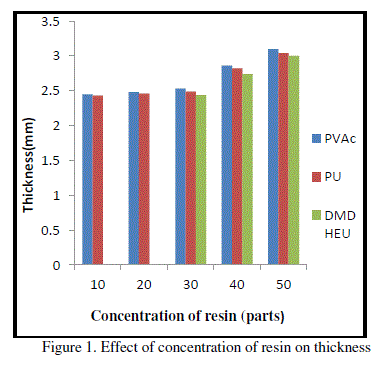 |
| From Table No.-1 & Fig.No.-1 it is observed that as the concentration of resins an increases there is an increase in thickness of composites irrespective of type of resin. As concentration an increase from 10 to 50 parts there is an increase in thickness. This may be because of an increase in crosslinking resin used for composite manufacturing.It is also observed that an increase in thickness trend in following manner in resins.PVAc>PU>DMDHEU. In case of DMDHEU at a concentration of 10 to 20 parts it is observed that ,there is no composite formation,that may be because that the concentration is not sufficient for bonding of chicken fibres. |
| B. Effect of concentration of Resin on GSM |
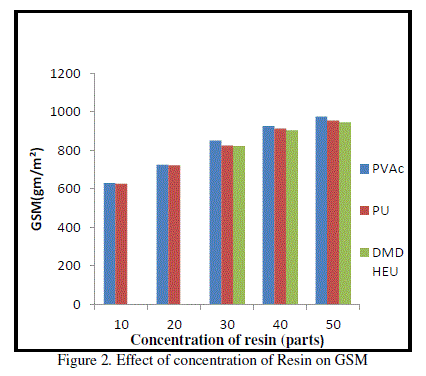 |
| From Table no-2 & fig.no.-2 it is observed that as the concentration of resin an increases there is an increase in GSM of composites irrespective of type of resin.As concentration an increases from 10 to 50 parts. There is an increase in GSM ,this may be because of an increase in crosslinking resin used for composite manufacturing. It is also observed that an increase in thickness trend in following manner in resins.PVAc>PU>DMDHEU. In case of DMDHEU at a concentration of 10 to20 parts it is observed that there is no composite formation,that may be because that the concentration is not sufficient for bonding of chicken fibres. |
| C. Effect of concentration of Resin on Air permeability |
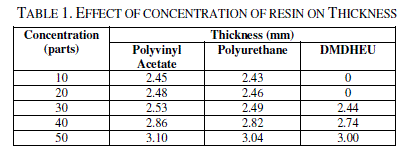 |
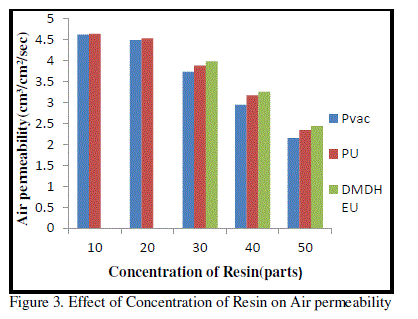 |
| From Table No-4 & Fig.no.-4 It is observed that as the concentration of resins an increases there is an increase in Bursting strength of composites irrespective of type of resin, as concentration an increases from 10 to 50 parts, there is an increase in bursting strength, this may be because of an increase in crosslinking resin used for composite manufacturing. It is also observed that an increase in bursts trend in following manner in resins, PVAc>PU>DMDHEU. Also in case of PVAc there is a strong bond formation,which leads to higher bursting strength. |
| E. Effect of concentration of Resin on Water Resistance |
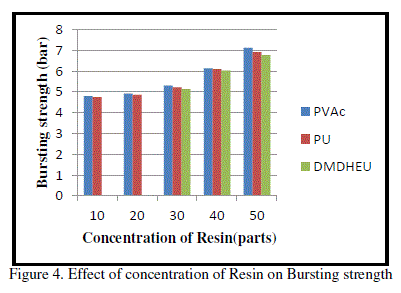 |
| From Table No-5 & Fig.No.-5 it is observed that as the concentration of resins an increases there is an increase in water Resistance of composites irrespective of type of resin.As concentration increases from 10 to 50 parts, there is an increase in Water Resistance, this may be because of an increase in crosslinking resin used for composite manufacturing. It is also observed that an increase in thickness trend in following manner in resins.PVAc>PU>DMDHEU. In this case PVAc forms thick film on the surface which causes an increase in water resistance. |
CONCLUSION |
| From the above results and discussion we can conclude that, chicken feathers can be used for manufacturing of nonwoven by using chemical bonding technique .In this case polyvinyl acetate gives better results as compared to other resins used for study. So chicken feathers along with polyvinyl acetate can be safely used for manufacturing of nonwoven.which controls the pollution load of chicken feathers. |
References |
|